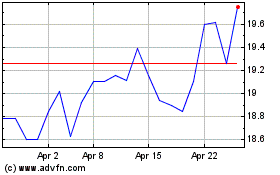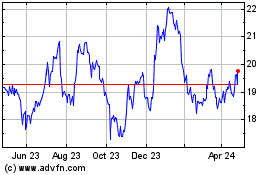Philips showcases ultra-low contrast PCI solutions at EuroPCR 2022
May 16 2022 - 5:00AM

Philips showcases ultra-low contrast PCI solutions at EuroPCR 2022
May 16, 2022
- Co-registration of real-time intravascular ultrasound and/or
iFR physiological assessment data onto motion-compensated
angiograms aids percutaneous coronary intervention (PCI) procedure
planning, quantitative lesion measurement, stent choice and sizing,
and therapy assessment
- Reduced need for contrast media enables broader access to PCI
for patients at risk of acute kidney injury
- Ultra-low contrast PCI procedures discussed in
Philips-sponsored symposium at EuroPCR 2022
Amsterdam, the Netherlands – Royal Philips
(NYSE: PHG, AEX: PHIA), a global leader in health technology, is
showcasing innovations at EuroPCR (May 17-20, Paris, France) that
can enable interventionists to perform ultra-low contrast
percutaneous coronary intervention (ULC-PCI) procedures with
greater confidence and clarity. Philips’ ULC-PCI solutions
co-register instantaneous blood flow measurements and/or
intravascular ultrasound (IVUS) images onto real-time fluoroscopy
to help interventionists diagnose, decide, guide, treat and confirm
the success of PCI, with the potential to limit the use of
iodinated contrast media.
Seamlessly integrating into Philips’ Image Guided Therapy System
- Azurion - the company’s unique ULC-PCI solutions provide
physicians with tools to help reduce the use of contrast media
throughout PCI procedures.
The ability to perform PCI procedures using a very small amount
of contrast media enables PCI to be offered to more patient groups,
notably patients presenting with both coronary artery disease (CAD)
and chronic kidney disease (CKD), who are at high risk of suffering
contrast-induced nephropathy (CIN) [1] - a life-threatening form of
hospital-acquired acute kidney injury (AKI) caused by contrast
media toxicity. A 2020 study in the USA concluded that AKI after a
PCI procedure resulted in an average increase in length of hospital
stay of 3.6 days and an additional healthcare cost of 9,448 USD per
patient [2].
“Innovation in catheter-based interventions to treat narrowed
heart arteries – so-called percutaneous coronary interventions –
continuous to contribute to improving the quality of life and
prognosis for millions of patients around the world,” said Javier
Escaned, MD, PhD, Head of the Interventional Cardiology Section at
Hospital Clinico San Carlos, Madrid, Spain. "As a result, more
complex patients can now undergo PCI, including those with advanced
age and frailty, chronic renal failure, and associated heart
conditions. In many of these patients, where the injection of
radiological contrast used to guide the PCI can have deleterious
effects, technologies developed by Philips that enable physicians
to dramatically decrease contrast administration during the
procedure is contributing to both the safety and quality of
PCI.”
Dynamic Coronary RoadmapDuring a conventional
PCI procedure, contrast media is injected into the patient’s
coronary arteries to acquire an angiogram, with additional
fluoroscopy used during the procedure to help interventionists
navigate their guide wires and catheters. To maintain visibility of
the arteries, this guidance typically requires repeated contrast
media injections, increasing the toxic load on the patient’s
kidneys. Philips’ Dynamic Coronary Roadmap software removes the
need for additional contrast media injection by overlaying the
preoperative angiogram onto real-time motion-compensated 2D
fluoroscopic imaging to provide interventionists with continuous
visual feedback on the positioning of guide wires and catheters. In
many cases, no additional contrast media injection is required for
wire navigation.
While Philips’ Dynamic Coronary Roadmap software helps
interventionists navigate guide wires and catheters to the site of
a lesion, the company’s IntraSight Series 7 precision guidance
system streamlines lesion assessment, simplifies vessel sizing, and
enables precise therapy delivery.
iFR Co-registrationAs an alternative or adjunct
to IVUS co-registration, spatially accurate instantaneous wave-free
ratio (iFR) pullback measurements can be co-registered onto the
angiogram, adding valuable physiological data to the anatomical
imaging. Unlike fractional flow reserve (FFR) measurements, iFR
measurements do not require the use of hyperemic drug injection and
can be used to assess both the degree and length of vessel stenosis
and the effectiveness of therapy using a simple pressure wire
pullback technique.
IVUS Co-registrationIntraSight Series 7’s IVUS
co-registration facility merges real-time intravenous ultrasound
and angiogram images, with information on the precise location of
the ultrasound images derived during manual pull-back of the
ultrasound catheter under continuous fluoroscopy. As a result,
interventionists can simultaneously view reconstructed
cross-sectional ultrasound images of the vessel lumen, including
their precise position on the angiogram. This level of precision
significantly reduces the risk of a ‘geographic miss’, which has
been estimated to occur in over 60% of PCIs [3]. IntraSight Series
7’s Angio+ quantitative coronary analysis software automatically
calculates lumen dimensions and stenosis in real time, helping
accurate assessment of the required stent
size. Tri-registrationIntraSight Series
7’s Tri-registration function aids stent selection by
co-registering IVUS and iFR information with the angiogram to help
choose a stent that optimally supports meeting a procedure’s
objectives. Coupled with IntraSight Series 7’s enhanced live stent
visualization capabilities, which help to immediately verify
correct stent positioning and deployment, the ability to enhance
stent choice and size means more right-first-time procedures and
better patient outcomes.
Ultra-Low Contrast PCI at EuroPCRProfessor
Javier Escaned, together with other key thought leaders in the
field of UCL-PCI, will discuss how to decrease operator dependence
on vessel opacification during PCI in a Philips-sponsored symposium
at EuroPCR 2022 on Tuesday, May 17, from 17:15 to 18:15 (CET). For
more information and registration, click here.
[1] Dangas G, et al. Contrast-Induced nephropathy after
percutaneous coronary interventions in relation to chronic kidney
disease and hemodynamic variables. AJC 2005.
https://doi.org/10.1016/j.amjcard.2004.08.056.[2] Amin P, et al.
Incremental cost of Acute Kidney Injury after Percutaneous Coronary
Intervention in the United States. AM J Cardiol. 2020
Jan1;125(1):29-331. [3] Costa et al. Impact of Stent Deployment
Procedural Factors on Long-term Effectiveness and Safety of
Sirolimus-Eluting Stents (Final results of the Multicenter
Prospective STLLR Trial), Am J Cardiol 2008 Jun 15;
101(12):1704-11.
For further information, please contact:
Joost Maltha Philips Global Press Office Tel:
+31 6 10 55
8116 Email: joost.maltha@philips.com
Fabienne van der FeerPhilips Image Guided TherapyTel: + 31 622
698 001E-mail: fabienne.van.der.feer@philips.com
About Royal Philips Royal Philips (NYSE: PHG, AEX: PHIA)
is a leading health technology company focused on improving
people's health and well-being, and enabling better outcomes across
the health continuum – from healthy living and prevention, to
diagnosis, treatment and home care. Philips leverages advanced
technology and deep clinical and consumer insights to deliver
integrated solutions. Headquartered in the Netherlands, the company
is a leader in diagnostic imaging, image-guided therapy, patient
monitoring and health informatics, as well as in consumer health
and home care. Philips generated 2021 sales of EUR 17.2 billion and
employs approximately 79,000 employees with sales and services in
more than 100 countries. News about Philips can be found at
www.philips.com/newscenter.
- Philips Image Guided Therapy System – Azurion
- Philips intravascular ultrasound (IVUS)
- Philips iFR
Koninklijke Philips NV (EU:PHIA)
Historical Stock Chart
From Mar 2024 to Apr 2024

Koninklijke Philips NV (EU:PHIA)
Historical Stock Chart
From Apr 2023 to Apr 2024
